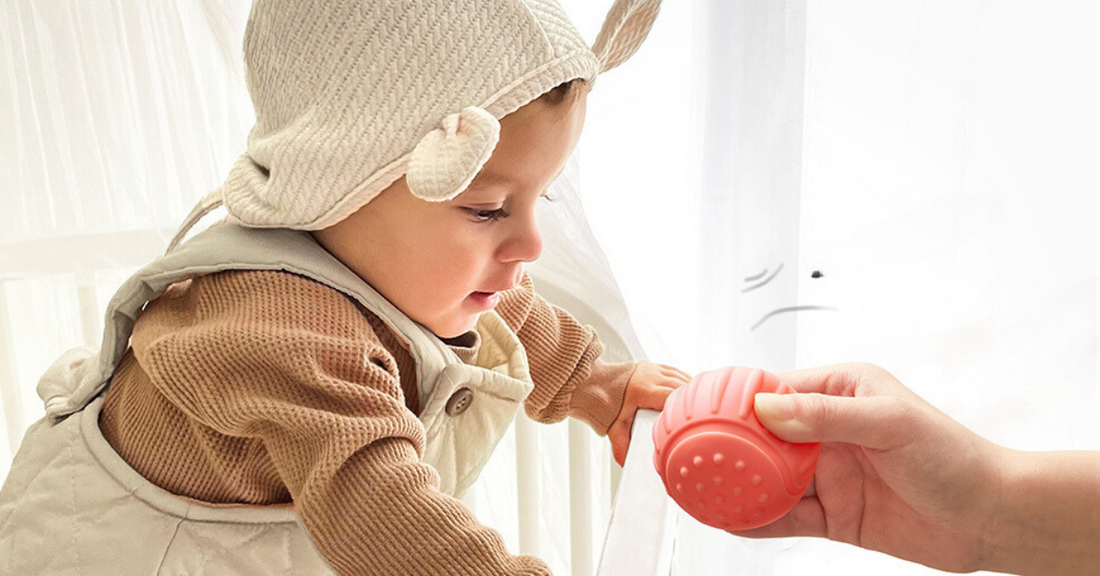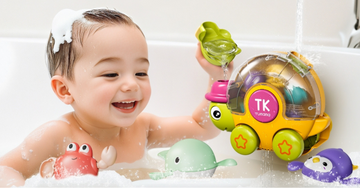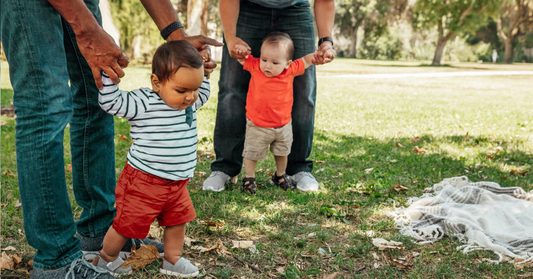아기에게 감각놀이가 중요한 이유?

아기에게 감각 놀이가 중요한 이유?
감각 놀이는 아기의 초기 발달에 필수적이며 신체적, 정서적, 인지적 능력의 성장을 장려합니다. 아기들은 촉각, 시각, 청각, 후각, 미각 등 오감을 사용하여 세상을 탐색하고 연결하며 기술을 연마합니다. 이번 포스팅에서는 감각 놀이의 중요성, 감각 장난감, 집에서 감각 장난감을 직접 만드는 방법까지 살펴보겠습니다.
감각 장난감이란 무엇입니까?
감각 장난감은 아기의 감각 중 하나 이상을 자극하도록 설계되었습니다. 이러한 장난감은 종종 밝은 색상, 다양한 질감, 차분한 소리 또는 관심을 끌고 탐색을 장려하는 흥미로운 패턴을 특징으로 합니다. 신생아의 경우 흑백 감각 장난감 카드나 고대비 딸랑이 같은 것이 이상적입니다. 아직 개발 중입니다. 아기가 성장함에 따라 조명, 음악, 부드러운 천이 있는 장난감은 다양한 감각을 자극할 수 있습니다.

감각 놀이가 중요한 이유와 감각 장난감의 장점?
감각 놀이는 아기의 전반적인 발달에 필수적이며, 감각 장난감은 이 여정에서 중요한 역할을 합니다. 그들은 함께 다음을 지원합니다:
- 뇌 발달 : 감각을 활용하면 새로운 신경 연결이 형성되어 문제 해결, 기억, 원인과 결과 이해와 같은 인지 능력이 향상됩니다.
- 운동 능력 향상 : 질감이 있는 장난감을 쥐거나 부드러운 물체를 쥐는 등의 활동은 손 근육과 협응력을 강화합니다.
- 정서적 성장 : 다양한 질감을 탐색하거나 차분한 소리를 듣는 것은 아기가 스스로 진정하고 감정을 처리하는 데 도움이 됩니다.
- 사회적, 상상력 : 감각 놀이에는 주로 유아의 경우 상호 작용, 의사소통 교육, 팀워크 및 창의성 교육이 포함됩니다.
감각 장난감은 단지 재미만 있는 것이 아닙니다. 또한 유아가 집중하고, 진정하고, 자신감을 가지고 주변 환경을 탐색하도록 돕습니다. 유아에게는 상상력이 풍부한 놀이를 장려하고 창의력을 강화하는 동시에 신체적, 정서적 성장을 지속적으로 키워줍니다.
감각 장난감 구입처
온라인과 오프라인 매장 모두에서 평판이 좋은 매장에서 고품질 아기 감각 장난감 을 찾을 수 있습니다. 인기 있는 옵션은 다음과 같습니다:
-
유아 전문 매장: 신생아부터 유아까지 적합한 다양한 장난감을 판매하는 경우가 많습니다.
-
온라인 소매업체:
Tumama Kids 와 같은 웹사이트에서는 다양하고 혁신적인 감각 장난감을 제공합니다. -
지역 수제 시장: 장인이 만든 독특한 감각 장난감을 이곳에서 흔히 찾을 수 있습니다.

작은 손에 딱 맞는 크기 –
각 교육용 번들에는 10개의 큐브가 포함되어 있습니다. 각 큐브에는 재미있고 밝은 색상의 동물, 문자, 숫자 패턴 등 다양한 패턴이 있습니다. 이 다기능 장난감은 숫자 세기, 색상, 모양 및 분류: '빨간색이 몇 개 있나요?' 및 언어: '이것은 무슨 동물인가요?'
를 소개하는 훌륭한 방법입니다.감각 장난감 만드는 법
집에서 감각 장난감을 만드는 데는 특별한 도구가 필요하지 않습니다. 창의성과 안전하고 아기에게 친숙한 재료만 있으면 됩니다.DIY 장난감은 예산이 저렴할 뿐만 아니라 자녀의 취향에 맞게 맞춤화할 수도 있습니다.
스스로 감각 장난감 만들기
돈을 절약하거나 개인적인 것을 만들고 싶은 경우? DIY 감각 장난감을 만드는 것은 아기의 취향에 맞게 장난감을 맞춤 설정할 수 있는 보람 있는 경험입니다. 간단하고 효과적인 아이디어를 위한 단계별 가이드는 다음과 같습니다.
질감이 있는 감각 가방
- 필요한 재료 : 재밀봉 가능한 대형 비닐봉지, 물, 반짝이, 구슬 또는 작은 물체(예: 단추 또는 폼 모양).
- 지침 :
- 백에 물을 반쯤 채우세요.
- 시각적 자극을 위해 반짝이와 작은 물체를 추가하세요.
- 과잉 공기를 짜내고 백을 단단히 밀봉합니다. 보안을 강화하려면 덕트 테이프로 가장자리를 테이프로 붙입니다.
- 안전한 탐색을 위해 가방을 평평한 표면에 놓거나 유아용 의자 트레이에 테이프로 고정하세요.
- 팁 : 누출을 방지하기 위해 백을 단단히 밀봉했는지 확인하세요. 놀이 중에 아기를 감독하세요.
유용한 시각적 가이드를 보려면 다음 튜토리얼을 시청하세요.
감각병
- 필요한 재료 : 투명한 플라스틱 병, 물, 식용 색소, 작은 물체(예: 단추, 장식술, 구슬), 반짝이(선택 사항)
- 지침 :
- 병에 물을 반쯤 채우세요.
- 활기찬 효과를 위해 식용 색소 몇 방울을 추가하세요.
- 다양성을 위해 작은 물체와 반짝이를 추가하세요.
- 병에 물을 채우고 움직일 수 있도록 약간의 공기를 남겨둡니다.
- 뚜껑을 단단히 조이고 글루건이나 접착 테이프로 밀봉하세요.
- 팁 : 푸른 물과 작은 바다 동물 조각상이 있는 바다 병과 같은 테마를 만드세요.
감각 병 만들기에 대한 시각적 가이드는 이 튜토리얼을 확인하세요. :
직물 견본 보드
- 필요한 재료 : 판지 또는 나무 틀, 다양한 직물(예: 실크, 벨벳, 데님, 펠트), 접착제 또는 스테이플
- 지침 :
- 천을 작은 정사각형이나 모양으로 자릅니다.
- 천을 판지나 프레임에 부착하고 접근 가능한 레이아웃으로 배열합니다.
- 가장자리가 매끄럽고 단단히 고정되었는지 확인하세요.
- 팁 : 라벨을 추가하거나 대비되는 색상을 사용하여 좀 더 나이가 많은 영유아가 시각적으로 보드를 흥미롭게 만들 수 있습니다.
DIY 소음 발생기
- 필요한 재료 : 빈 플라스틱 용기(예: 요구르트 컵), 마른 쌀, 파스타 또는 콩, 테이프 또는 접착제.
- 지침 :
- 용기를 소량의 마른 재료로 채웁니다.
- 흘림을 방지하기 위해 접착제나 테이프로 뚜껑을 고정하세요.
- 컬러풀한 테이프나 스티커로 용기를 장식해 매력을 더해보세요.
- 팁 : 쌀과 함께 부드러운 딸랑이 소리 또는 파스타와 함께 더 큰 딸깍 소리와 같은 다양한 음향 효과를 위해 다양한 재료를 사용하십시오.
DIY 감각 장난감은 형이나 동생을 위한 장난감을 만드는 데 형제자매를 참여시킬 수 있는 좋은 기회를 제공합니다.게다가 가격도 저렴하고 끝없는 엔터테인먼트를 제공합니다!
결론
감각적인 놀이는 아기의 성장에 매우 중요한 부분이며, 장난감은 발달을 향상시키는 데 핵심적인 역할을 합니다. 탐구 신생아 감각 카드 나만의 DIY 장난감 제작에 이르기까지 자녀의 학습과 창의력을 지원할 수 있는 방법은 무궁무진합니다.
시작 준비? 감각 장난감에 투자하거나 집에서 직접 만들어 보세요! 발견을 시작해보세요.







0 댓글